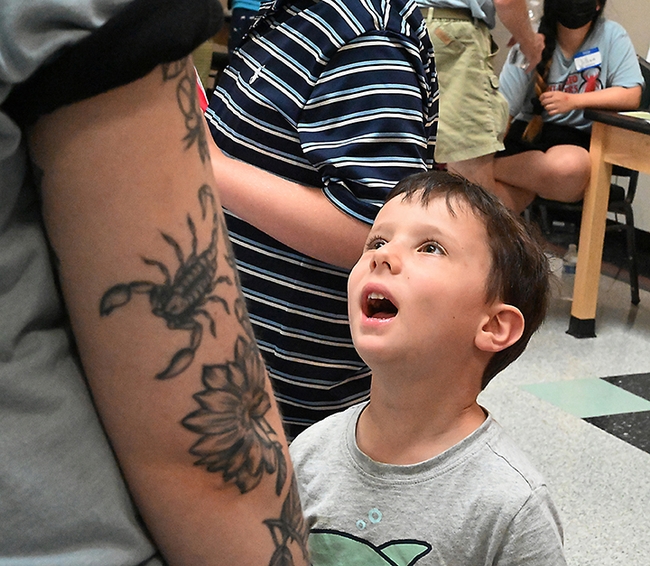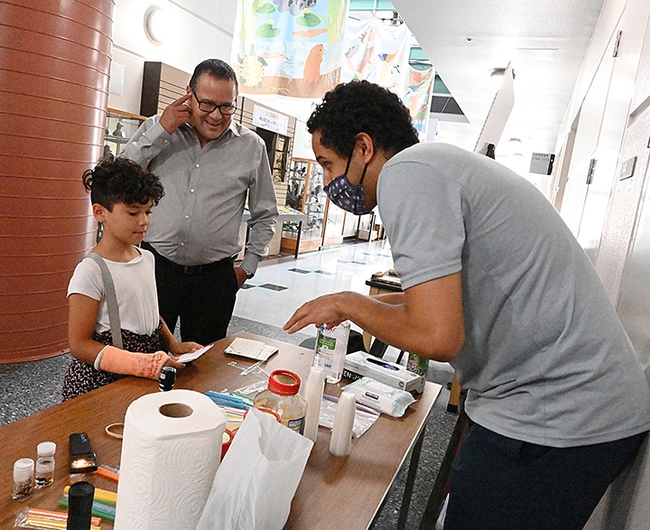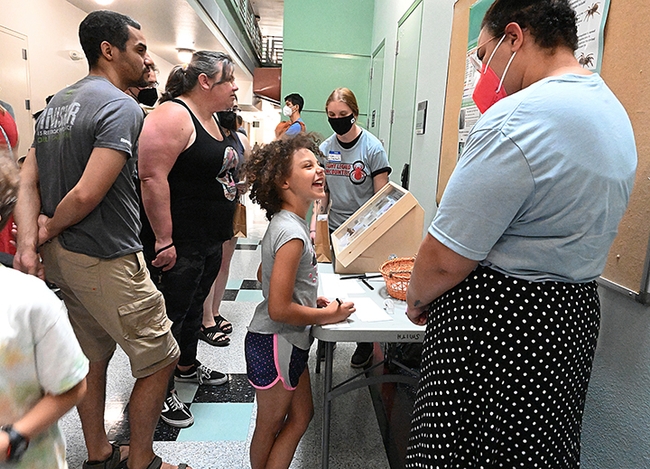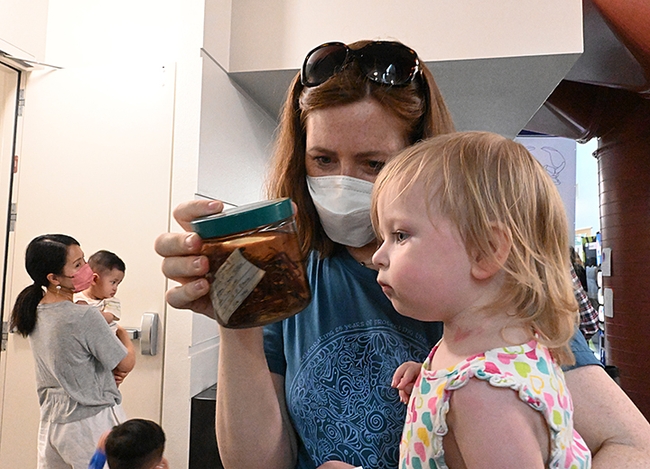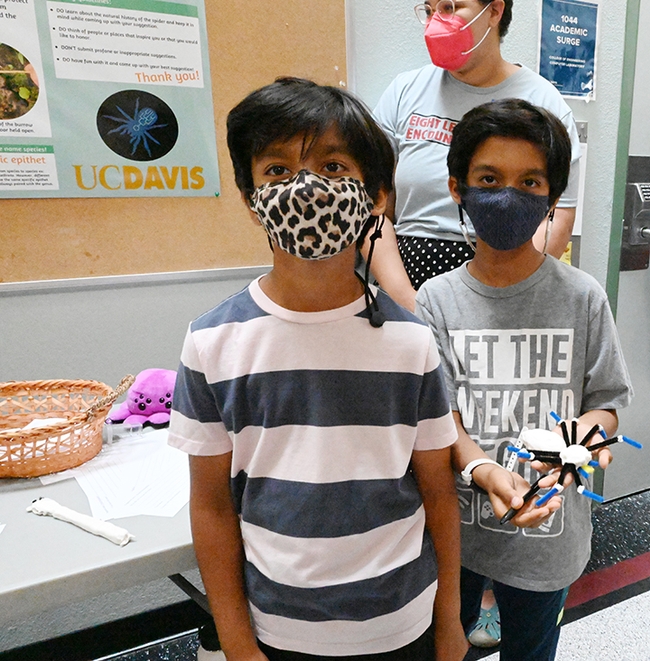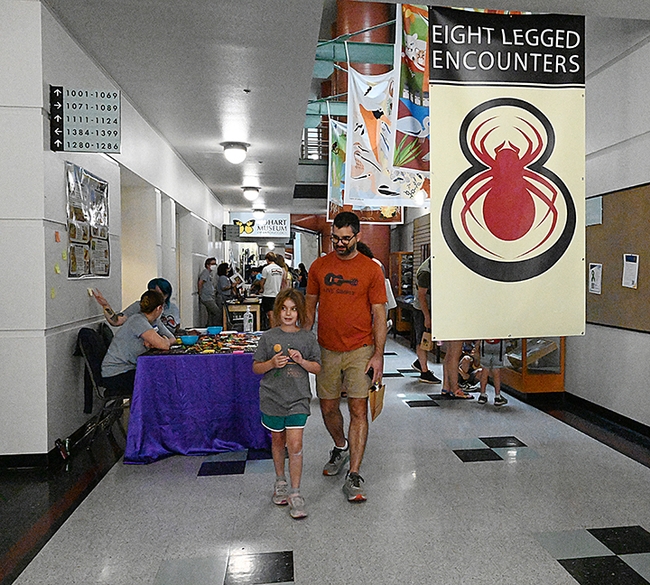- Author: Kathy Keatley Garvey
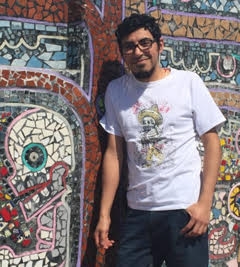
What, you don't? They scare you? And you scream?
Fear not.
Arachnologists will set the record straight. (Maybe not your scream, though!)
Just in time for Halloween, the next UC Davis Department of Entomology and Nematology seminar will be on spiders.
Arachnologist Rodrigo Monjaraz-Ruedas of San Diego State University's Department of Biology, will speak on "Ring Species, Ring Speciation or a Ring of Species? An Example with California Mygalomorph Spiders" at 4:10 p.m., Monday, Oct. 30 in Room 122 of Briggs Hall. It also will be on Zoom.
The Zoom link:
https://ucdavis.zoom.us/j/95882849672
"Ring species can be defined as a chain of interbreeding populations which expands along two pathways around a geographic barrier, where terminal forms can coexist without interbreeding," Monjaraz-Ruedas writes in his abstract. "A broken ring species model preserves the geographic setting and fundamental features of an idealized model but accommodates varying degrees of gene flow restriction through evolutionary time. Members of the genus Calisoga are distributed around the Central Valley of California, and previous genetic studies have shown that this is a lineage-rich complex of mygalomorph spiders, with evidence to suggest that Calisoga might be a case of ring speciation. Here we examine broken ring species dynamics in Calisoga spiders, using UCEs and mitogenomes we test key predictions of timing, ancestry, connectivity and terminal overlap. I will discuss why ring species should not be viewed as homogeneous entities, but rather as heterogeneous units with different predicted evolutionary dynamics in different geographic parts of the ring."
Monjaraz-Ruedas joined the Marshal Hedin lab at San Diego State University as a postdoctoral research fellow in 2020. He studies "Phylogenomic, spatial phylogenetics and conservation prioritization in trapdoor spiders (and kin) of the California Floristic Province."
The Hedin lab focuses on arachnids, with particular emphasis on mygalomorph spiders and Opiliones (harvesters)," according to its website. "Species discovery, delimitation and description is important to us--although the biological world is amazingly diverse, most biodiversity remains undiscovered and undescribed. We spend a considerable amount of time conducting fieldwork--the western US and Appalachian mountains are hotspots for our research efforts. Cave arachnids interest us! In the lab we strive to be integrative, but our strength lies in molecular phylogeography and phylogenomics."
Monjaraz-Ruedas' most recent publications include:
- Cruz-López, J. A., Monjaraz-Ruedas, R. Colmenares, P. A. & Francke, O. F. 2021. Historical
biogeography of a neglected family of armoured harvestmen (Opiliones: Laniatores: Icaleptidae) with the first record and a new genus for tropical Mesoamerica. Invertebrate Systematics. 35: 493– 513. - Francke, O. F., Monjaraz-Ruedas, R., Cruz-López, J. A. 2021. Biodiversity of Huautla Cave System, Oaxaca, Mexico. Diversity. 13: 429.
- Monjaraz-Ruedas, R.,. Francke, O. F. & Prendini, L. 2022. World Travelers: parthenogenesis and ecological tolerance enable multiple colonization events by the widespread short-tailed whipscorpion, Stenochrus portoricensis (Schizomida: Hubbardiidae). Insect Systematics and Diversity. 6(1): 7, 1–17.
- Monjaraz-Ruedas, R., Mendez, R.W., Hedin, M. (2023). Species delimitation, biogeography, and natural history of dwarf funnel web spiders (Mygalomorphae, Hexurellidae, Hexurella) from the United States / Mexico borderlands. Zookeys. 1167: 109–157.
- Monjaraz-Ruedas, R., Starret, J., Dean Leavitt, D., Hedin, M. (In Review). Ring species dynamics in California mygalomorph spiders (Nemesiidae, Calisoga). The American Naturalist.
Monjaraz-Ruedas holds three degrees from the Universidad Nacional Autónoma de México (UNAM): a bachelor's degree in taxonomy; a master's degree in morphological systematics; and a doctorate in molecular phylogenetics. His doctoral dissertation: “Systematics of the genus Stenochrus Chamberlin, 1922 (Schizomida: Hubbardiidae).”
He has guest-lectured on arachnids at San Diego State University, and was a member of the UNAM science faculty, serving as a lecturer in systematic biology from 2019 to 2020. He also worked as an assistant collection manager of the arachnids collection, UNAM Biology Institute, from 2010-2013.
Seminar coordinator is Brian Johnson, associate professor, UC Davis Department of Entomology and Nematology. For Zoom technical issues, he may be reached at brnjohnson@ucdavis.edu. The list of seminars is posted here.
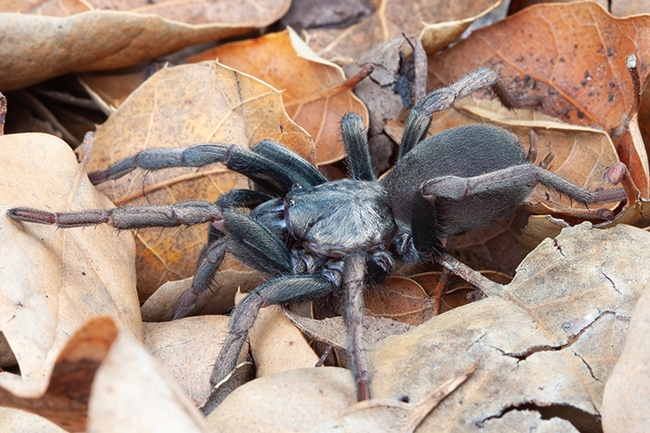
- Author: Kathy Keatley Garvey

That includes spiders. You've seen those adorable jumping spiders with green "fangs" (chelicerae), right? But have you even seen the green lynx spiders?
A few years ago we spotted a green lynx spider, Peucetia viridans, on a pink rockrose blossom. Arachnologists tell us it's usually found on green plants--green on green--which is exactly why we can't find it!
Meanwhile, want to see and learn about spiders?
Then you'll want to attend the Bohart Museum of Entomology open house, themed "Many Legged Wonders," from 1 to 4 p.m., Saturday, March 18 in Room 1124 of the Academic Surge Building, 455 Crocker Lane. Yes, it's free. So is parking. And yes, it's family friendly. The family arts-and-crafts activity, coordinated by UC Davis doctoral candidate Emma Jochim, of the Jason Bond arachnology lab will be working with model clay to mold arachnids and myriapods.
Jochim and fellow doctoral candidate Xavier Zahnle of the Bond lab will answer your questions about spiders from 1 to 1:30. First-year graduate student Iris Quayle of the Bond lab will moderate the session. Lab members also will show some "rarer live arachnids such as 'vinegaroons' and 'whip spiders' in addition to tarantulas and scorpions," Jochim said. "We will also have millipedes that people can handle and many species of isopods."
A showing of live animals and specimens is scheduled from 1:30 to 4 p.m. Elijah Shih, a third-year UC Davis transfer student who plans to pursue a career in veterinary medicine, will show his isopods. Bohart Museum research associate Brittany Kohler, the "zookeeper" of the Bohart petting zoo, will show the current tenants, which include tarantulas, black widows, a brown widow, a centipede, Madagascar hissing cockroaches, stick insects and ironclad beetles.
Of course, the tarantulas sport such endearing names as "Princess Herbert," "Peaches" and "Coco McFluffin." Much better than "Killer," "Fang" or "Monster Man."
The Bohart Museum, part of the UC Davis Department of Entomology and Nematology, is directed by UC Davis distinguished professor Lynn Kimsey. It houses a global collection of eight million insect specimens, plus the live petting zoo, and a gift shop stocked with insect-themed books, posters, jewelry, t-shirts, hoodies and more. The Bohart Museum was founded in 1946 and named for UC Davis professor and noted entomologist Richard Bohart.
The Bohart Museum, dedicated to "understanding, documenting and communicating terrestrial arthropod diversity," is open to the public Mondays through Thursdays, from 8 a.m. to noon, and 1 to 5 p.m. More information is available on the Bohart website at https://bohart.ucdavis.edu or by emailing bmuseum@ucdavis.edu.
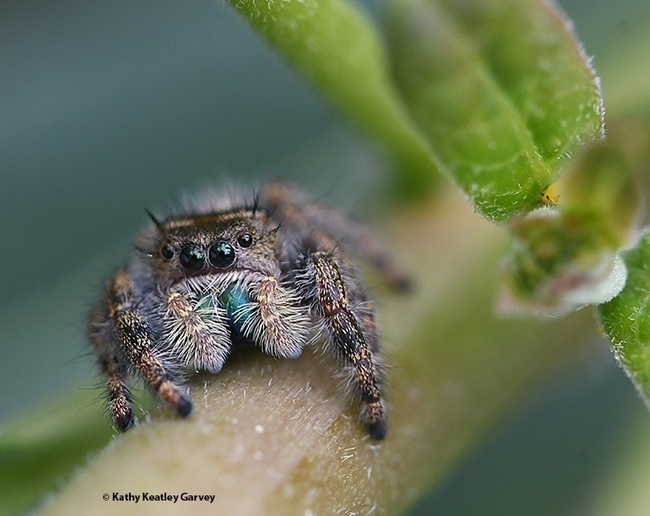
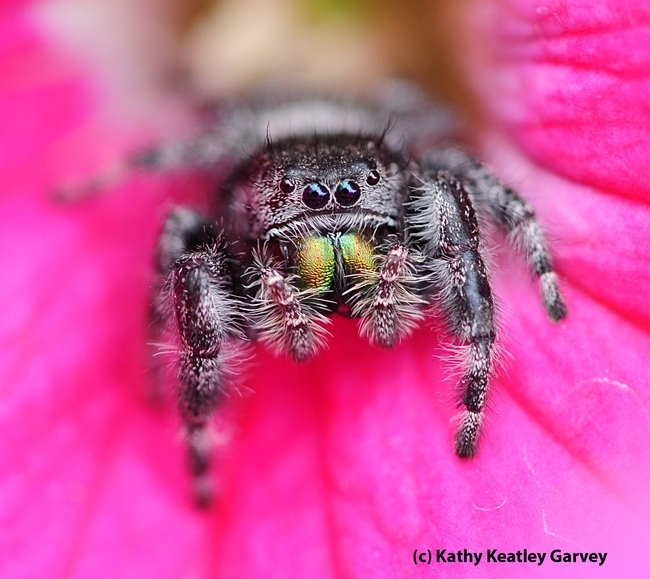
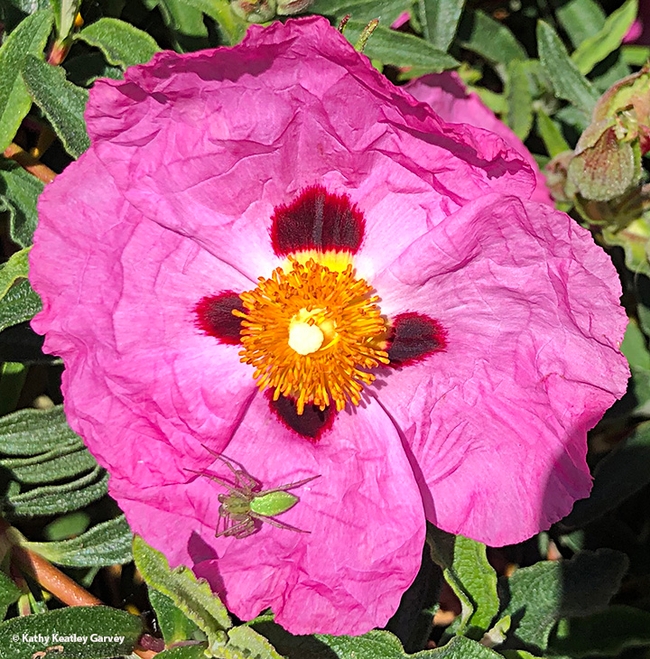
- Author: Kathy Keatley Garvey

If you said "14," go to the head of the class.
Is it an insect? No, it's a crustacean.
When the Bohart Museum of Entomology hosts an open house on "Many-Legged Wonders" from 1 to 4 p.m., Saturday, March 18, among the critters showcased will be spiders, millipedes, centipedes, scorpions, tarantulas, and yes, isopods.
The event, free and family friendly, takes place in Room 1124 of the Academic Surge Building, 455 Crocker Lane, UC Davis campus.
Elijah Shih, a third-year UC Davis transfer student studying neurobiology, physiology and behavior, will show his isopods. “Isopods come in many morphs and sizes," he says. "There are many colorful and beautifully patterned isopods, some natural, some man made. Isopods are crustaceans and require moisture to breathe and molt properly. Some species have the ability to conglobate or roll up in to the ball where as others do not. They are great for helping create a bioactive system for reptiles, planted tanks, and a great feeder for young reptiles and amphibians.”
“There are many isopod species in the world," Shih related, “and at least five common isopod species that are found in California: Porcellio laevis, Porcellio scaber, Armadillidium vulgare, Porcellio dilatatus, and Cubaris marina. Their morphs are considered wild type.”
Shih, who hopes to pursue a career in veterinary medicine, said he houses “many reptiles, both aquatic and terrestrial, such as the box turtle and gargoyle gecko. I wanted to create bioactive environments for my reptiles—(mainly to not have to pick up the feces)-- so I looked for ways to make that possible. I need something that was small, agile, prolific, and safe to be eaten. Isopods, better known as Rollie pillows or pill bugs, are the best solution for me. I had my isopods, but to complete the cleanup crew, I added springtails to help clean up any leftover food, but more importantly, the mold.”
Tabatha Yang, education and outreach coordinator for the Bohart, announced that doctoral candidates Emma Jochim and Xavier Zahnle of the Jason Bond arachnology lab will dispel myths about spiders and millipedes at a question-and-answer session from 1 to 1:30. Doctoral student Iris Quayle will moderate.
From 1:30 to 4 p.m., will be the general open house with a showing of live animals and specimens. Bohart Museum research associate Brittany Kohler, the "zookeeper" of the Bohart petting zoo, says the current residents include:
- Princess Herbert, a Brazilian salmon-pink bird-eating tarantula (Lasiodora parahybana), age estimated to be around 20 (current oldest resident)
- Peaches, a Chilean rose hair tarantula (Grammostola rosea)
- Coco McFluffin, a Chaco golden knee tarantula (Grammostola pulchripes)
- Beatrice, a Vietnamese centipede (Scolopendra subspinipes), newest resident
- Two black widows (Latrodectus hesperus)
- One brown widow (Latrodectus geometricus)
Among the other residents are Madagascar hissing cockroaches, a giant cave cockroach, stick insects, a bark scorpion and ironclad beetles. A family arts-and-crafts activity is also planned.
The Bohart Museum, directed by UC Davis distinguished professor Lynn Kimsey, houses a global collection of eight million insect specimens, plus the petting zoo and a gift shop stocked with insect-themed books, posters, jewelry, t-shirts, hoodies and more. Dedicated to "understanding, documenting and communicating terrestrial arthropod diversity," the Bohart Museum was founded in 1946 and named for UC Davis professor and noted entomologist Richard Bohart. The insect museum is open to the public Mondays through Thursdays, from 8 a.m. to noon, and 1 to 5 p.m.
More information is available on the Bohart website at https://bohart.ucdavis.edu or by emailing bmuseum@ucdavis.edu.


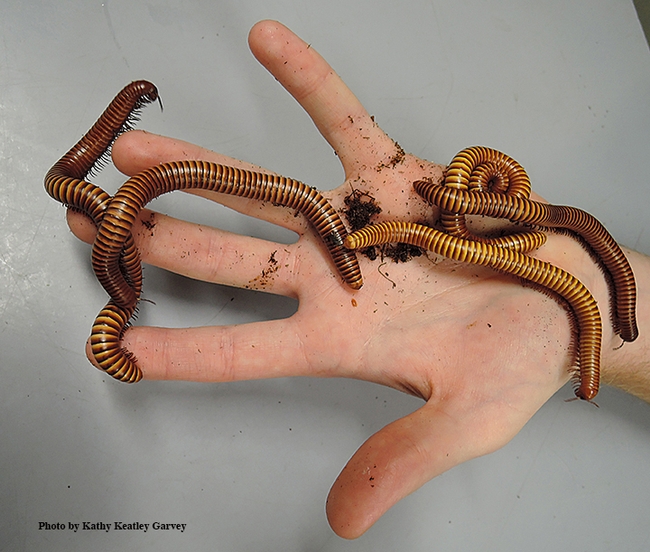
- Author: Kathy Keatley Garvey
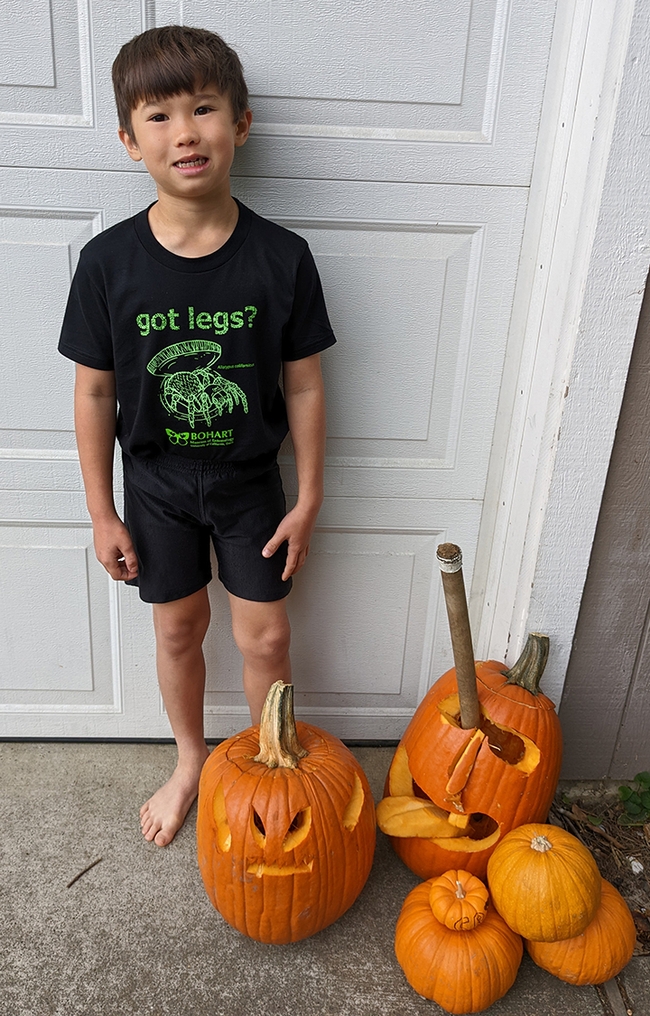
Ironically, some folks proclaim their hatred or disgust for all things spiders throughout the year, but when the Halloween season arrives, they're thinking webs, fangs and eight legs as perfect decor for their door.
And to scare the bejeezus out of trick-or-treaters, the postal employee (who goes postal), cousins (who become distant) and other folks approaching the front porch who wish they hadn't.
So, it's good to see the Bohart Museum of Entomology come up with a "Got Legs?" spider t-shirt in its gift shop this week. It's a trapdoor spider, or what arachnologist Jason Bond of UC Davis studies. Bond is the associate dean, College of Agricultural and Environmental Sciences, and the Evert and Marion Schlinger Endowed Chair in Insect Systematics, UC Davis Department of Entomology and Nematology. In June, 2022, he co-hosted the American Arachnological Society's "Eight-Legged Encounters" conference at UC Davis. The focus on spiders also included a Bohart Museum's open house, "Eight-Legged Wonders!"
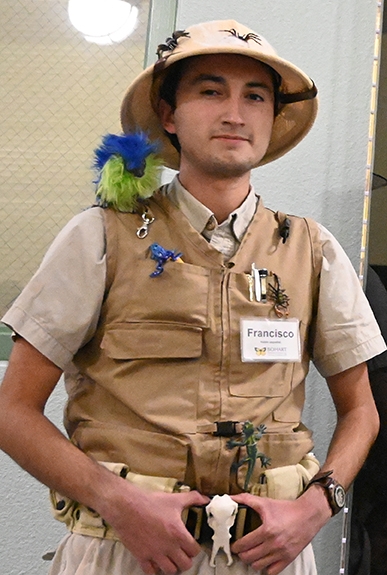
"We designed it together and Francisco did the art," Keller said.
"I think it's fantastic," said Lynn Kimsey, director of the Bohart Museum and a UC Davis distinguished professor of entomology. "I haven't seen any other t-shirts featuring spiders like this."
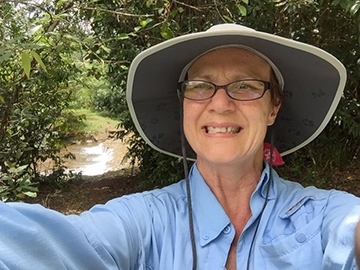
The gift shop offers the spider t-shirt in both youth and adult sizes. The youth t-shirt glows in the dark.
The Bohart Museum, founded in 1946, is located in Room 1124 of the Academic Surge Building, 455 Crocker Lane, UC Davis campus. Named for UC Davis professor and noted entomologist Richard Bohart, it is open to the public from 8 a.m. to noon, and 1 to 5 p.m., Mondays through Thursdays. The insect-themed gift shop, stocked with t-shirts, hoodies, books, posters, jewelry, insect-collecting equipment and more, is open year-around and is also online.
Now back to spiders. We remember asking Professor Bond five good reasons why folks should like spiders. (See Bug Squad blog)
- Spiders consume 400-800 million tons of prey, mostly insects, each year. Humans consume somewhere around 400 million tons of meat and fish each year.
- Spider silk is one of the strongest naturally occurring materials. Spider silk is stronger than steel, stronger and more stretchy than Kevlar; a pencil thick strand of spider silk could be used to stop a Boeing 747 in flight.
- Some spiders are incredibly fast – able to run up to 70 body lengths per second (10X faster than Usain Bolt).
- Athough nearly all 47,000-plus spider species have venom used to kill their insect prey, very few actually have venom that is harmful to humans.
- Some spiders are really good parents –wolf spider moms carry their young on their backs until they are ready to strike out on their own; female trapdoor spiders keep their broods safe inside their burrows often longer than one year, and some female jumping spiders even nurse their spiderlings with a protein rich substance comparable to milk.
Spiders rock! And yes, they got legs...
Eight. Of. Them.
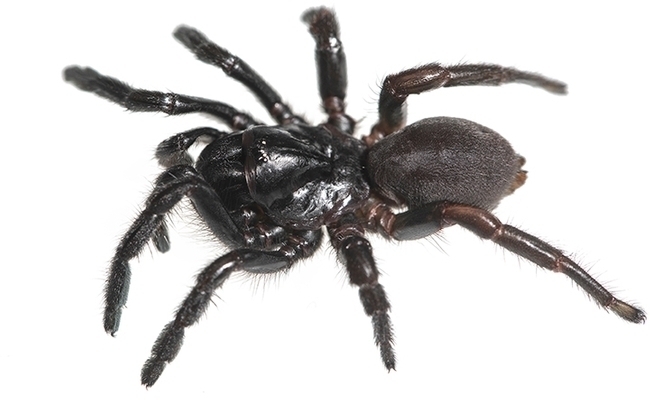
- Author: Kathy Keatley Garvey
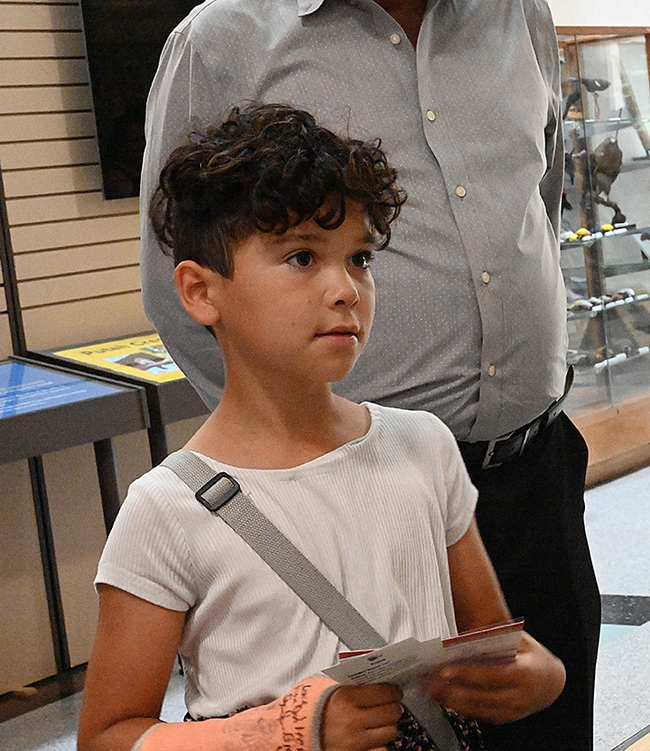
Photos, that is, of children's candid expressions?
Priceless.
Curiosity, delight and awe punctuated the open house, co-hosted by the Bohart Museum of Entomology and the American Arachnological Society (AAS), last Saturday afternoon in the Academic Surge Building, Crocker Lane, UC Davis campus.
The event drew Iael Raij-Hoffman, a postdoctoral scholar in the UC Davis Department of Land, Air and Water Resources, and her son, Shaked Hoffman, 5, of Davis.
Marta Erismann, 8, of Sacramento, attended with her father, Fernando Erissmann. "She has her sights set on attending UC Davis when she grows up," the father shared. He said he will be studying biomedical engineering in graduate school this fall at UC Davis.
Alexis Rainwater, 8, of Woodland, attending with her parents, participated in many of the activities, including crafting a spider, and submitting a name for the new species of spider in a contest coordinated by the Jason Bond arachnology lab.
Twenty-one-month-old Eleanor Bielski was fascinated by a jarred spider specimen that her mother, Laura McKay held up for her to see.
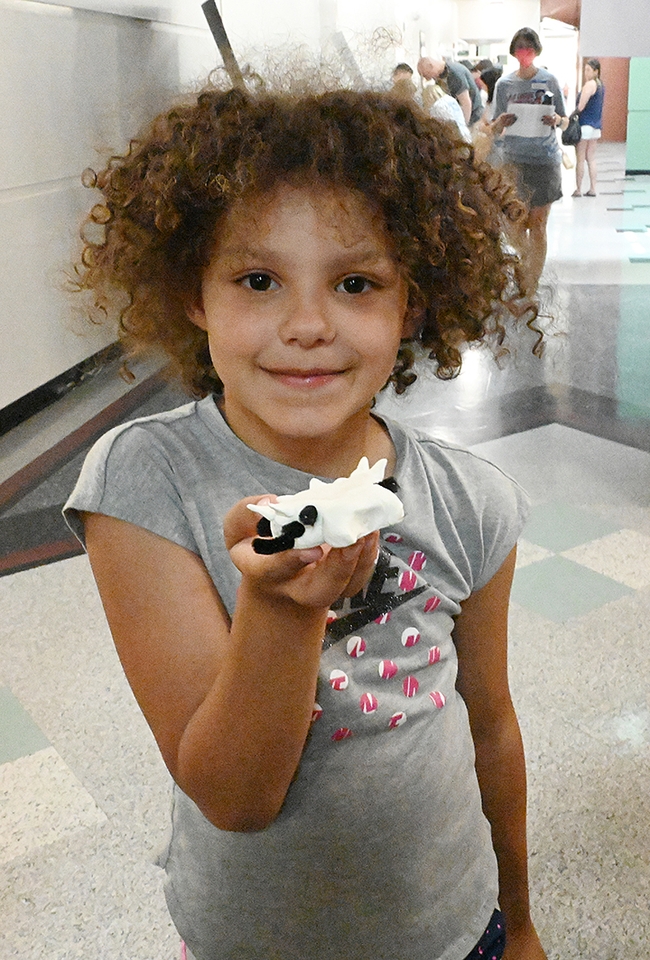
The open house, "Eight-Legged Encounters, " was a free, family friendly event and an opportunity to talk to the "powerhouse" of arachnologists enrolled in the American Arachnological Society (AAS) conference at UC Davis. The open house kicked off their June 26-30 meeting.
Some 20 tables with exhibits and hands-on activities lined the hallway of Academic Surge on Crocker Lane, UC Davis campus. The Bohart Museum, located in Room 1124, showcased spiders as well as insects. The museum houses a global collection of eight million insect specimens, as well as a live "petting zoo" (Madagascar hissing cockroaches, stick insects and tarantulas) and an insect-themed gift shop.
The hallway tables featured spider specimens, live arachnids, and art and science activities, noted AAS conference co-chair and arachnologist Jason Bond, associate dean, College of Agricultural and Environmental Sciences, and the Evert and Marion Schlinger Endowed Chair in Insect Systematics, UC Davis Department of Entomology and Nematology.
Co-host of the open house was Professor Eileen Hebets of the School of Biological Sciences, University of Nebraska, Lincoln, recipient of a U.S. National Science Foundation grant, “Eight-Legged Encounters,” designed to connect arachnologists with communities, especially youth.
Hebets seeks to educate the public “about the wonders of biology and the possibility of scientific discovery using a charismatic and engaging group of animals--arachnids. Arachnids (spiders and their relatives) are ubiquitous, thriving in most habitable environments on our planet (including underwater),” she says on her website.
On Tuesday, June 28, AAS is sponsoring a series of arachnid lectures, free and open to the public, from 7:30 to 9 p.m. in the newly constructed 600-seat lecture hall, California Hall. The event will be casual, with scientists discussing their work, Bond said.
